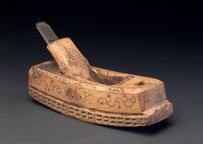

Gear for broach

Gear for broach
Broaching is the process of removing material by pushing or pulling across the surface to be machined a tool called a broach having a number of teeth or cutting edges of graded length which successively engage the work. Breaks staggered in successive teeth prevent chip crowding and reduce chip width. The last few teeth are of the exact shape required and the operation is completed in a single traverse.
Broaching enables intricate forms to be produced with great rapidity. A gear-form broach and a keyway broach together with examples of an internal gear before and after broaching and a broached lock barrel are exhibited.
The principle of broaching first occurs in a design by Leonardo da Vinci (C.A. 16 R.C) of a tool for cutti ng iron bars. Then, in 1729, Christopher Polhem in Sweden used broaches in a machine for cutting clock wheels. In the mid nineteenth century broaching tools called drifts were hammered or pressed through the work.
The modern use of broaching is due to J. N. Lapointe, who established a factory to make broaches and broaching machines in 1902.
Details
- Category:
- Hand and Machine Tools
- Object Number:
- 1962-366
- type:
- gear
- credit:
- Lapointe Machine Tool Co.




